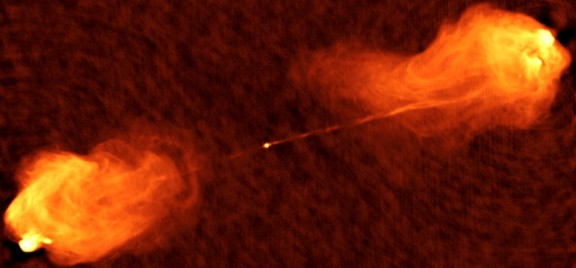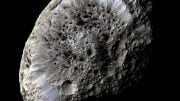
An image taken at radio wavelengths of the dramatic jets of charged particles being ejected from the nucleus of the galaxy Cygnus-A.
Astronomers used the Low Frequency Array radio telescope to obtain high spatial resolution images of the hotspots in Cygnus A, providing the first direct evidence that the spectral shape difference previously inferred is real.
The nucleus of a so-called “active” galaxy contains a massive black hole that is vigorously accreting material. As a result, the nucleus often ejects bipolar jets of rapidly moving charged particles that radiate brightly at many wavelengths, in particular radio wavelengths. Active galaxies display a range of dramatically different properties, and the ones that are bright in the radio can beam as much as one trillion solar luminosities of radiation into space at those wavelengths.
The intense emission arises from the hot environment of the black hole because electrons, moving at close to the speed of light in an environment of strong magnetic fields, radiate in the radio. The directed particle jets eventually collide with the ambient medium and convert much of their bulk energy of motion into shocks. The points of termination in the jet flow are seen as very hot spots, bright and compact structures. The hotspots can reverse the flow of the jets back toward the black hole, and thereby generate additional turbulence and random motions. The characteristic temperature of a hot spot (or more accurately, the spectral dependence of the brightness versus wavelength) reveals the nature of the physical processes at work. Most known active radio galaxies have hotspots whose spectral dependence conforms well with the idea of termination shocks and reverse flows, but some very luminous radio galaxies do not conform.
The radio galaxy Cygnus A is the nearest and most powerful example of a double radio galaxy and as such is an archetype of this class. It is also one of the first objects discovered whose hotspots did not seem to conform with the conventional picture, and for decades astronomers have debated the possible reasons. The limited ability of long wavelength (low frequency) radio telescopes to resolve the small sizes of the hotspots was one complicating factor. CfA astronomers Reinout van Weeren and Gianni Bernardi (now at SKA South Africa) were part of a large team who used the Low Frequency Array (“LOFAR”) radio telescope to obtain high spatial resolution images of the hotspots in Cygnus A. Their results provide the first direct evidence that the spectral shape difference previously inferred is real. The scientists are presenting a detailed analysis in a separate paper, but in this paper the basic results indicate that some other process besides shock activity must be involved; the team suggests absorption of the radiation by intervening local material could be part of the final picture.
Reference: “LOFAR Imaging of Cygnus A – Direct Detection of a Turnover in the Hotspot Radio Spectra” by J. P. McKean, L. E. H. Godfrey, S. Vegetti, M. W. Wise, R. Morganti, M. J. Hardcastle, D. Rafferty, J. Anderson, I. M. Avruch, R. Beck, M. E. Bell, I. van Bemmel, M. J. Bentum, G. Bernardi, P. Best, R. Blaauw, A. Bonafede, F. Breitling, J. W. Broderick, M. Brüggen, L. Cerrigone, B. Ciardi, F. de Gasperin, A. Deller, S. Duscha, D. Engels, H. Falcke, R. A. Fallows, W. Frieswijk, M. A. Garrett, J. M. Grießmeier, M. P. van Haarlem, G. Heald, M. Hoeft, A. J. van der Horst, M. Iacobelli, H. Intema, E. Juette, A. Karastergiou, V. I. Kondratiev, L. V. E. Koopmans, M. Kuniyoshi, G. Kuper, J. van Leeuwen, P. Maat, G. Mann, S. Markoff, R. McFadden, D. McKay-Bukowski, D. D. Mulcahy, H. Munk, A. Nelles, E. Orru, H. Paas, M. Pandey-Pommier, M. Pietka, R. Pizzo, A. G. Polatidis, W. Reich, H. J. A. Röttgering, A. Rowlinson, A. M. M. Scaife, M. Serylak, A. Shulevski, J. Sluman, O. Smirnov, M. Steinmetz, A. Stewart, J. Swinbank, M. Tagger, S. Thoudam, M. C. Toribio, R. Vermeulen, C. Vocks, R. J. van Weeren, O. Wucknitz, S. Yatawatta and P. Zarka, 24 August 2016, MNRAS.
DOI: 10.1093/mnras/stw2105









Outflows are ubiquitous in astrophysics. Despite different sizes, velocity and amount of transported energy, luminosity and degree of collimation, they have obvious morphological similarities. However, what is important for us, there is the picture of the outflows from everywhere and none of inflows into somewhere. That is an obvious asymmetry.
Outflows are needed to balance the ubiquitous inflow of gravity. if the sum of blueshifts from jets balances the cosmic redshift, there is no need for singularities in space (black holes having no singularity, but a bipolar outflow as is observed at every astrophysical blackhole) or singularity in time (Big Bang removed from consideration, replaced by a billion cosmic engines functioning across all space at all times, as is observed.)